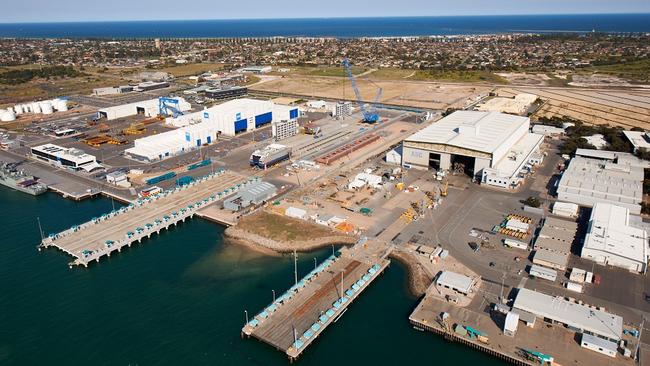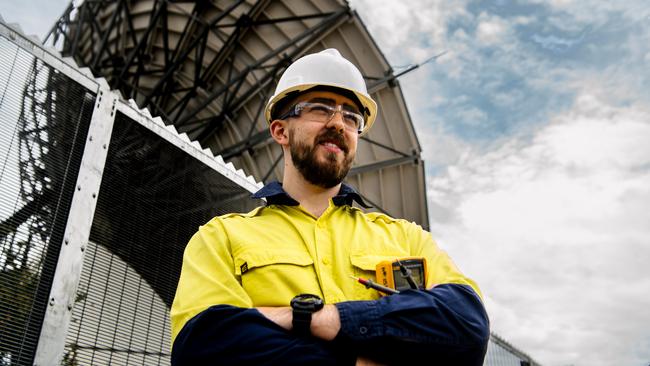State Government targets Holden engineers for high-skilled shipbuilding work
Defence and GM officials have held talks on retraining Holden engineers to move to the Osborne shipyard, when the car brand ends next year.
SA News
Don't miss out on the headlines from SA News. Followed categories will be added to My News.
- Naval Group pledges to spend 60% of contract in Australia
- Future of Collins Class maintenance remains unclear
- GM to retire Holden brand
Hundreds of Holden engineers and designers could be redeployed to work on the nation’s multi-billion dollar future submarines and frigate projects when the brand leaves Australia next year.
It comes as South Australia is in a race to secure up to 15,000 construction and supply-chain jobs associated with shipbuilding projects.
Defence Department officials and the Naval Shipbuilding College, based in Adelaide, held talks with General Motors representatives last week about redeployment opportunities for Holden staff when the company ends its Australian operations next year.
It’s understood the workers, based in Victoria, would have to relocate to work on the frigates or submarines being built at Adelaide’s Osborne shipyard.

Defence Industry Minister Melissa Price told The Advertiser there was an “immediate need” for designers and engineers across the shipbuilding sector, and Holden staff were “the sorts of people we want”.
“Holden’s workforce has broad experience in global design capability, manufacturing processes, digital-human integration, and testing,” she said. “It is expected that a program of bridging or conversion courses will be required to get the workers ready for a job in the shipbuilding sector, or the wider defence industry.”
Meanwhile Ian Irving, boss of the Naval Shipbuilding Institute that manages the college, has flagged a raft of initiatives to attract shipbuilding workers in SA.
They include launching an online jobs board, so workers can see what jobs are available with defence contractors, and new bridging courses and designer traineeships that the college wants to launch with the State Government.
“Our first one is being discussed right now,” Mr Irving told The Advertiser.
“That’s around the designer category and the drafting personnel that we need large numbers of in the immediate term.”
The college’s role is to identify skills gaps and work with training institutes to fill them.
It is also working with an online careers information platform, WorkReady, to attract high school students, and will conduct a jobs and training roadshow around the country, starting in Adelaide in May.
Mr Irving said shipbuilding was a “great opportunity” for SA but the whole country needed to be mobilised for the projects to be successful.
The college has released a snapshot of 21 job categories that will be needed over the next four years, prompting calls for the State Government to offer more incentives to attract young apprentices.
Combat-systems engineers, designers, subcontract administrators and mechanical engineers are already needed this year.
Test and activation engineers, welders and other trades will be needed from 2021 to 2023, while electrical and mechanical trades will be needed from 2024.
SA’s four major higher education institutions – TAFE SA, Flinders University, UniSA and Adelaide University – are partnering with the Naval Shipbuilding College to train people to help fill the 15,000 construction and supply-chain jobs needed over the next seven years.
But there are also 17 other institutions across the country offering college-endorsed courses, including two in Western Australia, three in Tasmania, three in Queensland, one in Darwin, four in New South Wales and five in Victoria.
SA Centre Alliance senator Rex Patrick said it was best for the future shipbuilding workforce to be trained in SA to minimise disruption, and to leverage off experienced trainers already in the industry.
Senator Patrick accused the Marshall Government of failing to offer enough incentives to both trainers and trainees to attract a sufficient workforce, which was being “exploited by people like WA Premier McGowan as WA tries to steal our work”.
Premier Steven Marshall said the state was “leaving no stone unturned” to secure the workforce.
That includes launching a specific workforce and skills strategy, and holding multiple roundtables with industry.
The State Government has also pushed for more information from the Naval Shipbuilding College about workforce demand to set education, training and migration targets.
“Defence SA and the Department of Innovation and Skills received some initial data under nondisclosure agreements with the NSC during 2019. However, this still lacks the detail needed to set targets,” the state’s submission to a Senate inquiry on naval shipbuilding said.
A Naval Shipbuilding College spokeswoman said workforce-demand information was shared with state governments, but she defended the use of nondisclosure agreements with defence contractors.
She said such agreements were needed to protect confidential corporate information.
This Ferrari’s defence career is fast-tracked

Rhys Ferrari took on an electronics apprenticeship with defence contractor BAE Systems almost four years ago and has never looked back.
The 21-year-old apprentice, who won BAE’s Apprentice of the Year last year, was advised against leaving his regular high school in Year 10 to pursue a trade through St Patrick’s Technical College.
But he’s glad he went with his gut and ignored the teacher who told him he was “stupid” to leave.
“It really made me second-guess myself, but I decided to go ahead with my plan, and I’m glad I did,” Mr Ferrari said.
He credits the Edinburgh North college with making him work-ready and helping to connect him with his employers, AI Group Training Services and BAE.
“Although only a small wage, I have been earning a full-time wage since the age of 17 which has given me a degree of independence, which I have enjoyed,” he said.
“My employer has paid all my training costs. I’m now in a position where I have a diploma, and I don’t have a HECS debt to pay off.”
Mr Ferrari is expecting a job offer when he finishes his apprenticeship in a few months’ time, but also hopes to go to university one day to do an engineering or project management degree.
About 3100 students were taking courses endorsed by the Naval Shipbuilding College nationally, as of October.
Ian Irving, who heads the Naval Shipbuilding Institute that manages the college, said future shipyard workers would be working on projects as complex as Elon Musk’s Space X program.
“Shipbuilding is not hot and heavy welding on a hot day. It’s a digitally integrated environment with robots and all of the sophisticated automation that we see in the most advanced factories on the planet,” he said.
WA’s TAFE defence boast is ‘an illusion’
South Australia will not match Western Australia’s bid to bolster its defence workforce by offering half-price TAFE courses.
In a bid to wrest full-cycle docking of Collins Class submarines from Adelaide, the WA Government has boasted of the success of its new TAFE plan. But the State Government has fired back, suggesting TAFE numbers from across the border pale in comparison to SA.
There is speculation in political circles that the contract, which includes 700 jobs in Adelaide, will be split between the two states, with blue-collar workers based in WA with the submarines.
In WA, the strongest argument put forward by the Labor-led State Government for such a switch is that SA will not be able to produce the workforce needed for the maintenance contract and future shipbuilding works.
WA Defence Issues Minister Paul Papalia told The Advertiser the half-price TAFE fees, for 34 courses including some related to defence, and a purpose-built TAFE campus at the Henderson shipyards near Fremantle, were working well.
“As part of its case for securing the full-cycle docking work, the State Government has indicated that if successful, it is willing to further invest in the South Metropolitan TAFE Naval Base Campus,” he said.
SA Skills Minister David Pisoni said it appeared WA was trying to “create an illusion of action” after recent national data on vocational education showed that WA’s decline in skills training was continuing.
